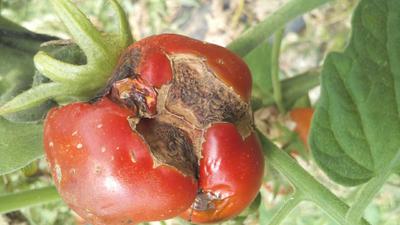Tomato Catface
Physiological Disorder
Other
In a Nutshell
- Severe malformation, scarring and cracking of the fruit at the blossom end.
Can also be found in
Symptoms
Catface is a physiological disorder that results in the malformation and scarring of fruits, often on the blossom end. Affected fruit have a somewhat lobulated shape, with corky brown scars between the different lobules that can extend deep into the flesh. It should not be mistaken with concentric or radial craking of the fruit. Although not marketable, misshapen fruits still retain their taste and can be consumed safely. Possible causes are cold weather with night temperatures below 12°C during flowering time, high nitrogen levels, and herbicide injury. The tomato varieties with very large fruits are more susceptible.
Recommendations

Organic Control
This disease can only be treated by preventive measures.

Chemical Control
Always consider an integrated approach with preventive measures and biological treatments if available. This disease can only be treated by preventive measures that are easy to implement. However, avoid the use of herbicides that can trigger the condition in particularly susceptible varieties.
What caused it?
The exact causes of catfacing on tomatoes are uncertain but it is generally more frequent on large-fruited varieties. Low night temperatures (12°C or below) for a number of successive days during flower bud development coincide with this physiological disorder, probably due to incomplete pollination of the flower. Some varieties may be more susceptible to these temperature shifts. Other impediments to flower bud development can also result in catfacing. Physical damage to the blossom, aggressive pruning or exposure to some herbicides (2, 4-D) can also lead to misshapen fruits. Excessive fruit growth due to unbalanced nitrogen supply could also be a cause. Finally, thrips damage or a condition known as tomato little leaf are also bound to result in catfacing.
Preventive Measures
- Use varieties, that are more tolerant to temperature shifts.
- Avoid the use of herbicides that can lead to this condition.
- Regularly monitor the temperature during the development of flower buds.
- Avoid physical injury to plants during field work.
- Keep track of nitrogen levels in soils before fertilizing.



